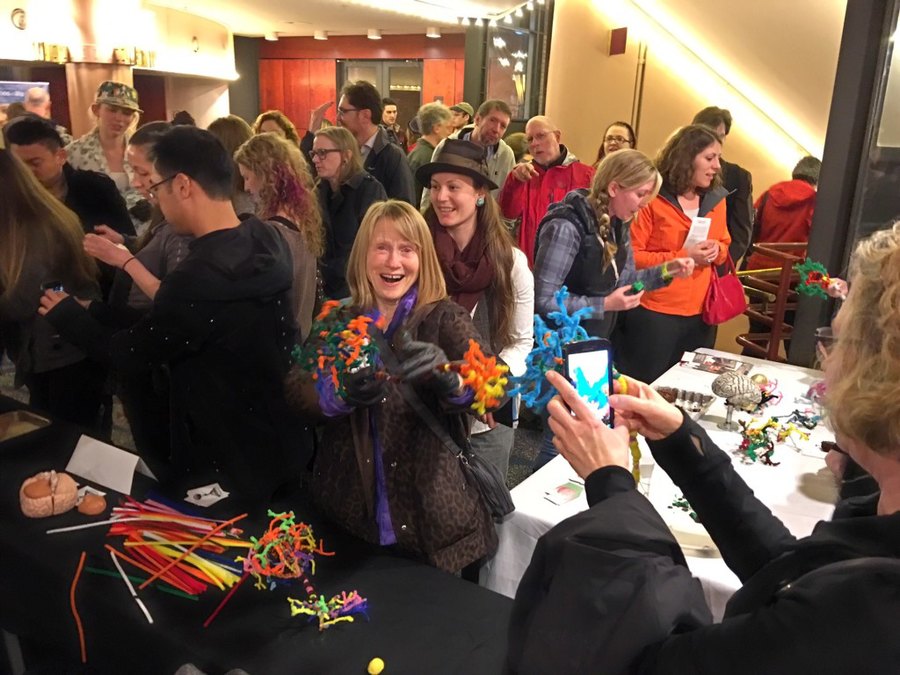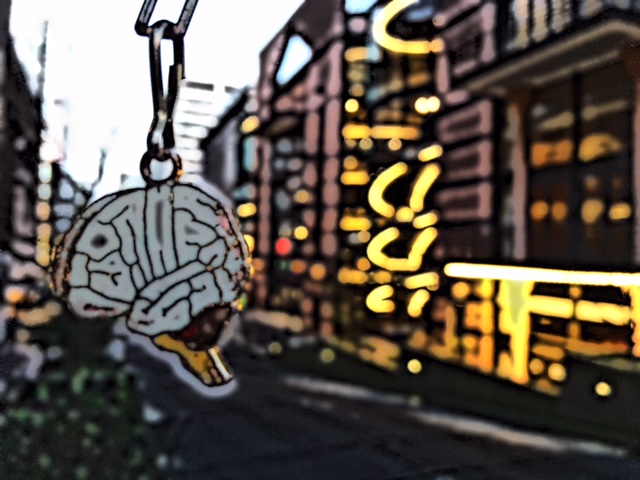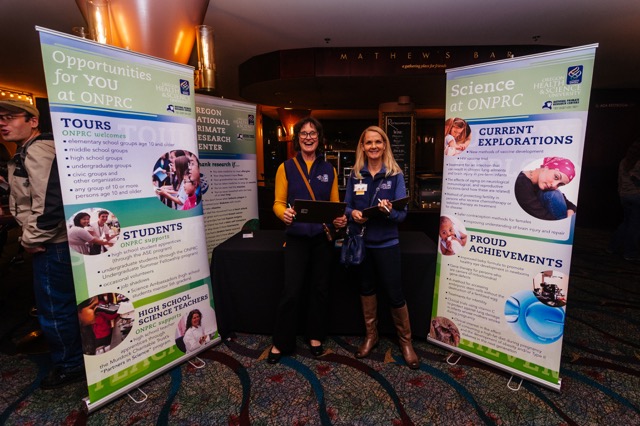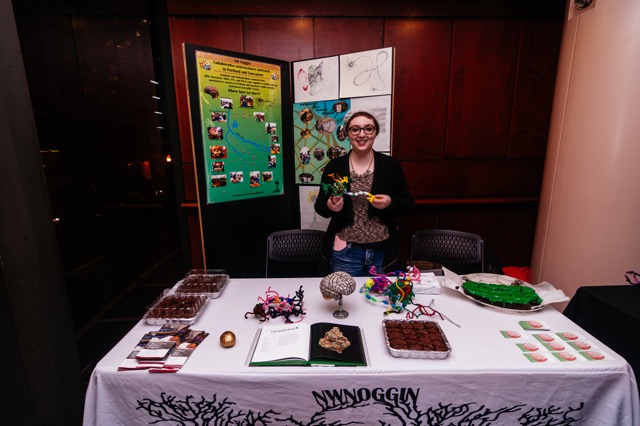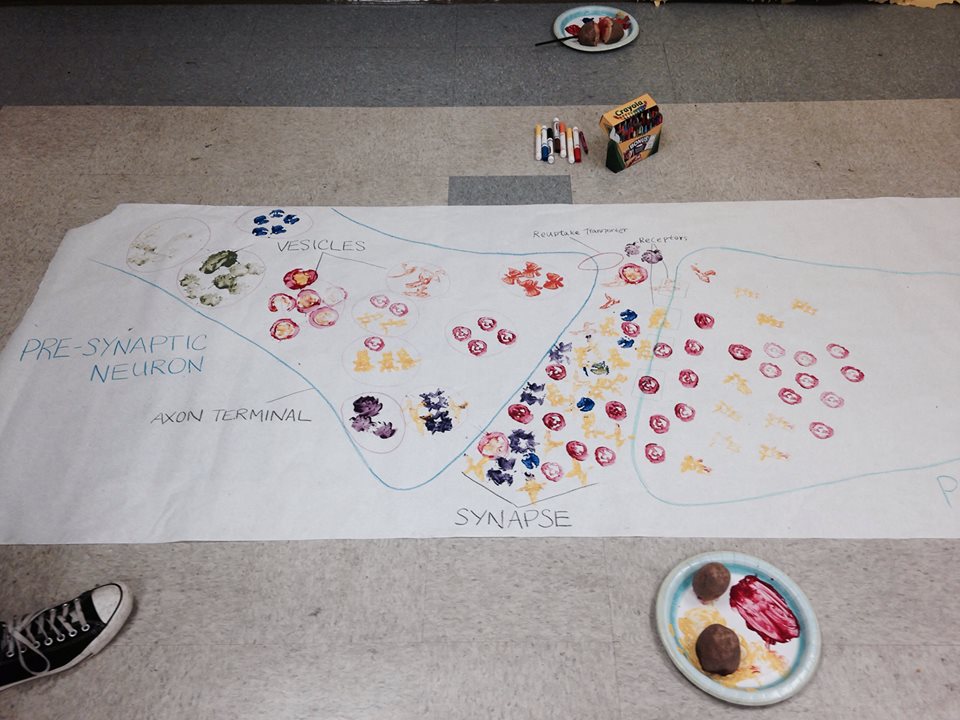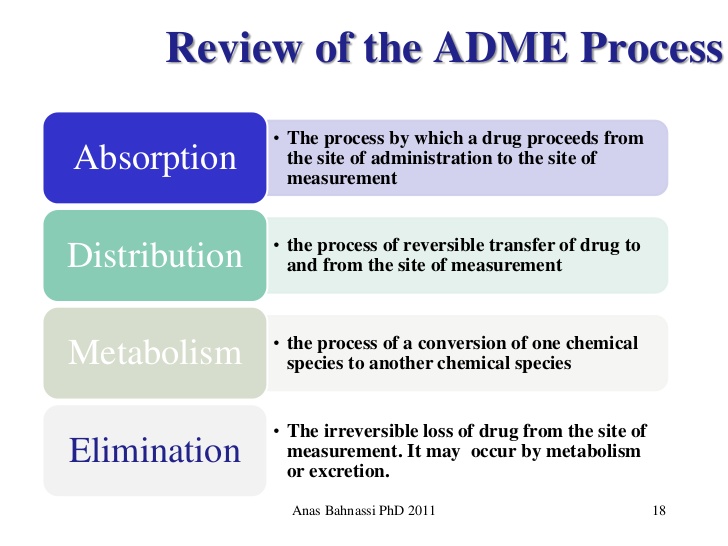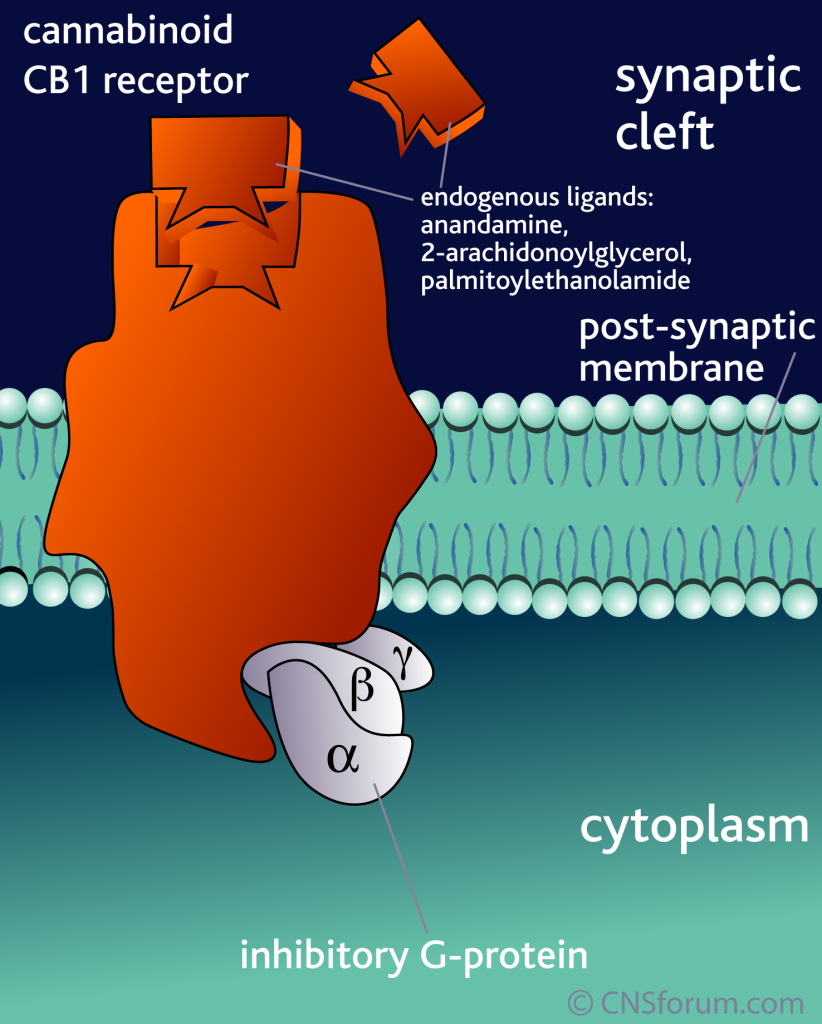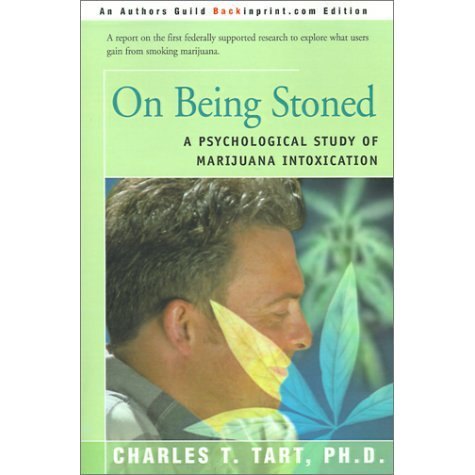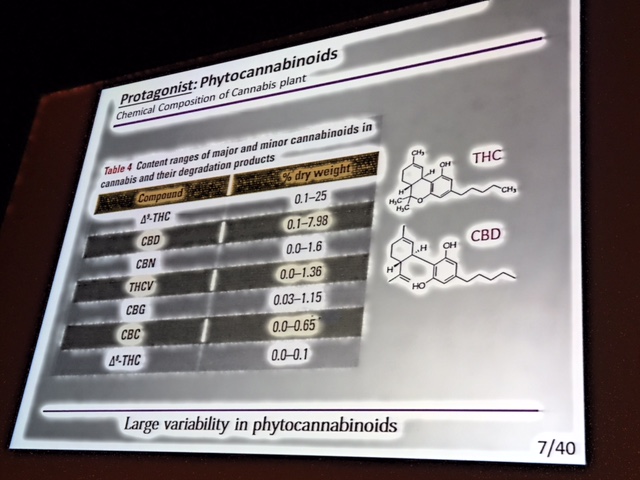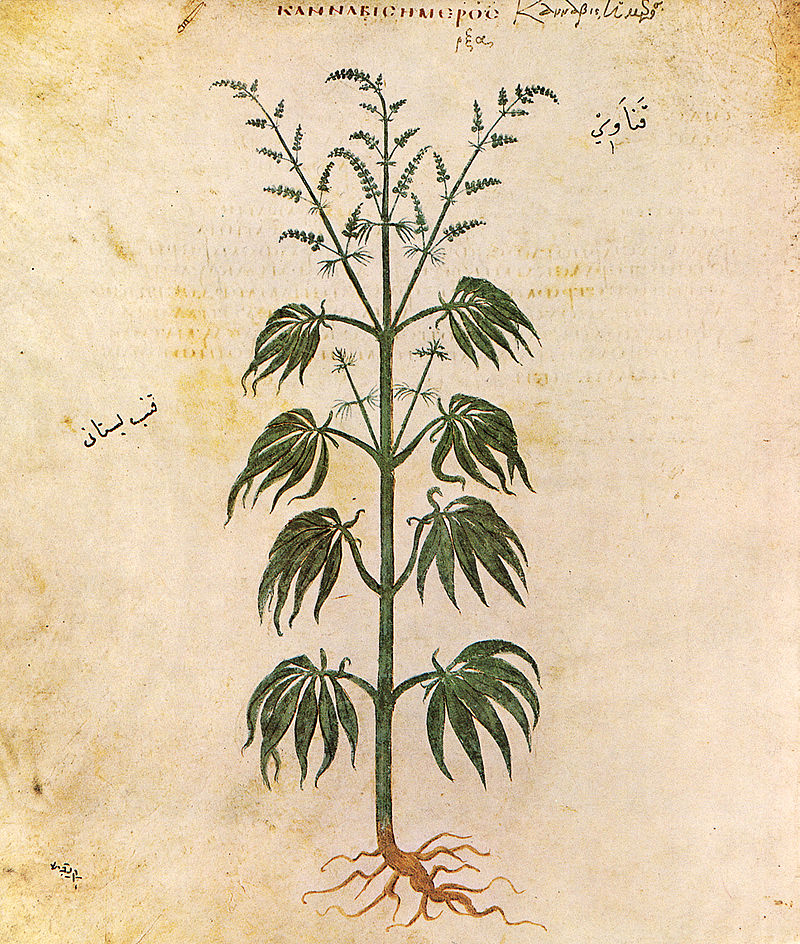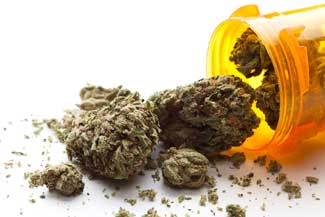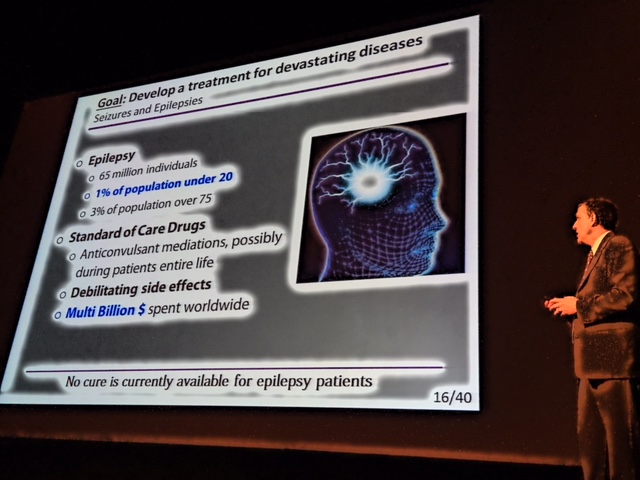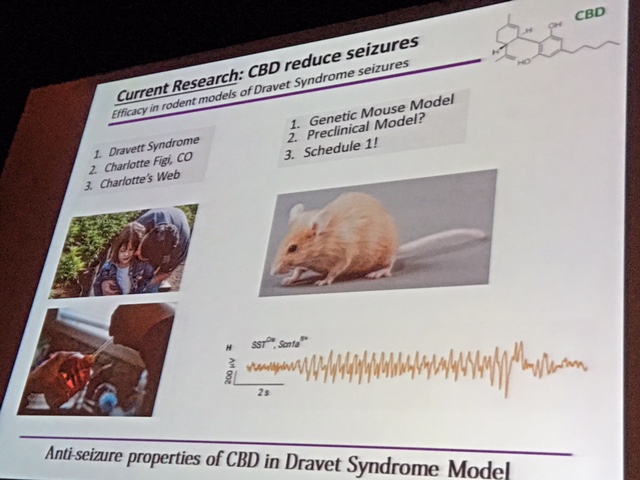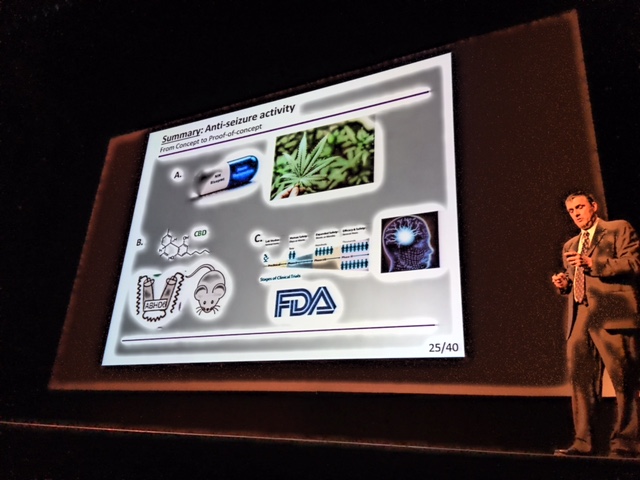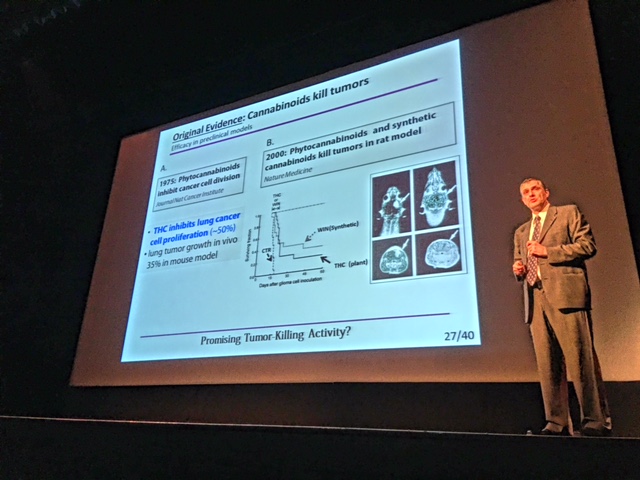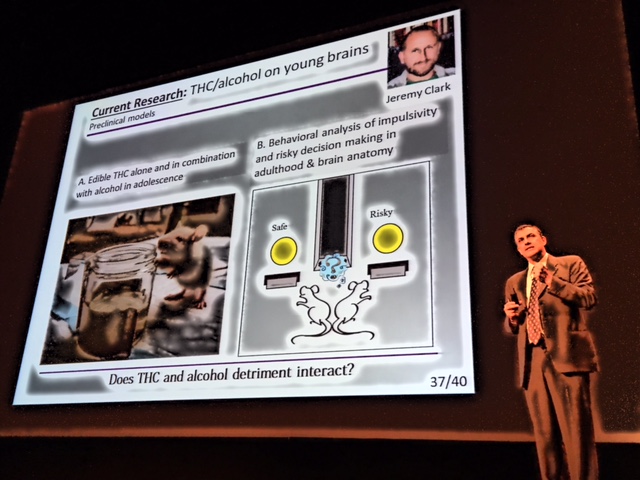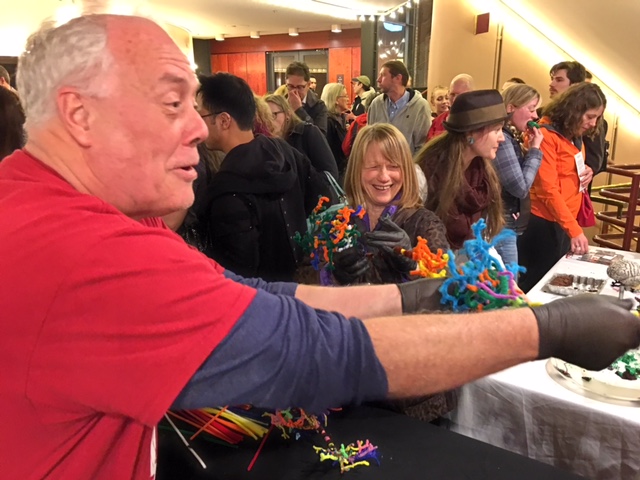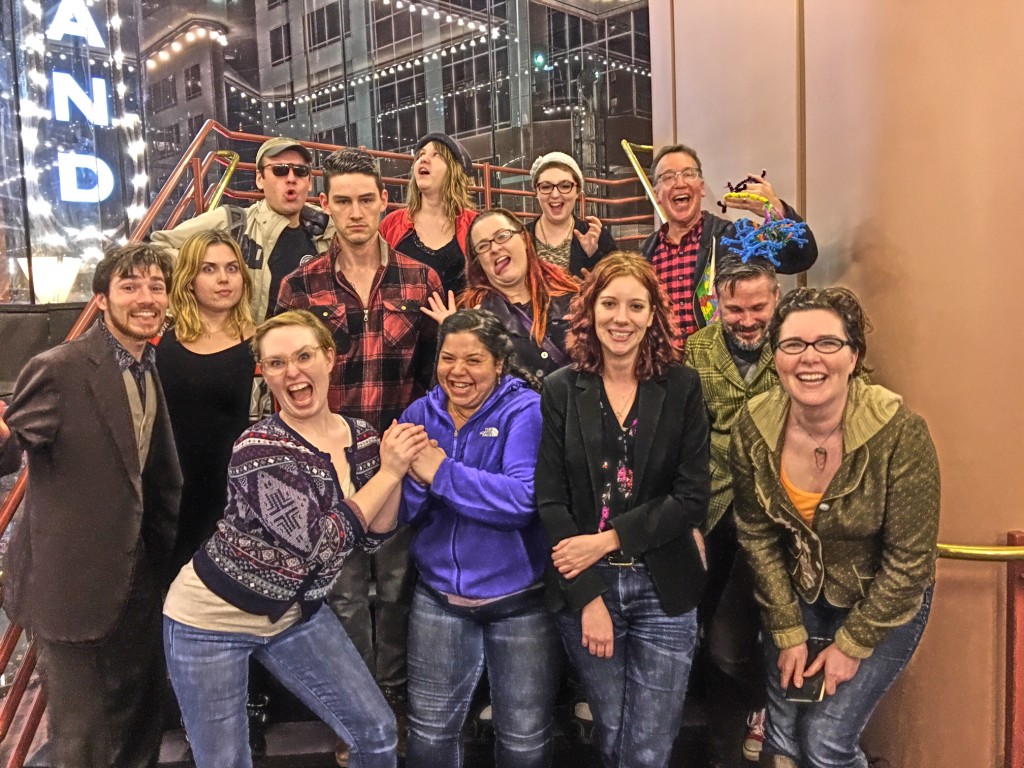Tonight Noggin offered visitors to the Newmark Theater a generous spread of colorful neurons, real brains, cannabis strain guides, and even home-baked brownies (the regular kind, thanks to Brianna Jacobs and Tara Leake)..!
This was the most popular, practically sold out lecture of Brain Awareness Season, and folks arrived early to admire Noggin neurons, eat those brownies, examine our cerebrums, and gaze at some glorious photographs of “Foggy Mountain,” “White Widow,” “Trainwreck, ” “LA Confidential,” and “Bubba Kush”…
Pics above by Alex Voigt
We had a healthy crowd of NW Noggin volunteers, including Chelsey Anderson, Courtney Miskell and Angela Hendrix from WSU Vancouver Neuroscience, and Jacob Schoen, Britt Gratreak, Alex Voigt, Brianna Jacobs, Gaile Parker, Austin Howard, Allie Clark, Bekah Alexander, and Jedidiah Acott from Psychology at Portland State…
We were there to hear Dr. Nephi Stella, a Professor in the departments of Pharmacology and Psychiatry & Behavioral Sciences at the University of Washington, discuss his research on how new drugs derived from marijuana can be used to treat brain cancer and epileptic seizures…
Dr. Stella began by noting the huge variability in chemical composition of marijuana plants, due to growing conditions, genetics, and which exact parts of the plant are in each purchased bag. Those evocative strain names, he lamented, were often nothing more than aspirational. A “Foggy Morning” in Portland, for example, might be significantly different than another “Foggy Morning” in Seattle…
That was one of several challenges to a burgeoning new legal industry (legal at least in the Pacific Northwest, Alaska, Colorado, Washington DC, and a growing number of additional locales) that Dr. Stella mentioned during a talk that often emphasized the clear therapeutic value of chemicals found in this plant…
Dr. Stella’s own lab, and now his startup company, Stella Therapeutics, are discovering novel uses for drugs derived from these cannabis chemicals, known as cannabinoids, including THC and cannabidiol (CBD), to treat often intractable diseases like epilepsy and glioblastoma multiforme, the most common deadly cancerous tumors in the brain…
Dr. Stella introduced two important concepts in pharmacology, or the study of drugs. Pharmacokinetics (“drug + movement”) describes how drugs get absorbed into the blood, and cross the blood brain barrier; that is, if, like cannabinoids, they can. Drugs are absorbed, distributed, metabolized, and eliminated (a.k.a., ADME). Pharmacokinetics is concerned with what the body does to the drug…
These drugs, including cannabinoids, are then bioavailable to their molecular targets in the brain, which are generally big proteins called receptors embedded in neuron membranes at synapses, the sites where neurons communicate with each other chemically, using neurotransmitters…
In contrast, pharmacodynamics (“drug + forces that stimulate growth, development, or change within a system”) describes what happens when drugs reach and act on receptors. It is concerned with what the drug actually does to the body and, in the case of cannabinoids, to the brain…
Delta-9 THC (or THC) and CBD are two of the most well-studied cannabinoids, and Dr. Stella described their pharmacodynamics – their actions at specific cannabinoid receptors (CB1 and CB2), which they fit structurally like keys into locks…
Source: The Cannabinoid Receptor (CB1 Receptor)
We also know their pharmacokinetics. These fatty (“greasy,” claims Dr. Stella) chemicals in marijuana are easily absorbed, and reach the brain, interacting with our own cannabinoid receptors. Inhalation delivers them much more quickly than eating brownies, of course, and sometimes users aren’t aware of how much they’ve consumed orally until it’s too late…
EXPLORE MORE: Maureen Dowd Freaked Out on Weed Chocolate (Vice, 2014)
However, these cannabinoid receptors, particularly CB1, are found in specific brain regions, including the hippocampus, basal ganglia, cortex and cerebellum, and cannabinoid drug action here definitely causes significant cognitive and behavioral effects…
EXPLORE MORE: Cannabinoid receptor localization in brain (Proc Natl Acad Sci USA. 1990)
Dr. Stella quoted early subjective reports of marijuana intoxication from a 1970 Nature paper by Charles Tart. Sensory effects, impairments of attention and short term memory, and a sense of time stretching out were common…
Dr. Stella paraphrased one subject: “I really like to get high on weekends because then my weekends are so long!” However, there were also highly variable effects, on social engagement and paranoia. According to Dr. Stella, the number one reason college students decide to avoid marijuana (and on average 75% of them will try it) is an initial paranoid experience.
Some variability likely relates to those highly diverse plants. Again, marijuana is not one drug, and the exact chemical composition changes from sample to sample. There are many phyto- (“plant-derived”) cannabinoids in cannabis, including THC and CBD. However, sativas, suggested Dr. Stella, are typically activating, and feel like uppers, while indicas (which tend to have more THC) are downers, and diminish motivation, and socializing with others…
The discovery of endogenous (“in the body”) cannabinoid receptors (CB1, CB2) – and also cannabinoid neurotransmitters, known as endocannabinoids – mirrors the discovery of endogenous opioid receptors and neurotransmitters. In both cases, there was an extensive, rich history of using plants for medicinal purposes: opium poppies for pain, and sleep, and cannabis for anesthesia, insomnia, headaches and pain…
Cannabis sativa from the Vienna Dioscurides (512 AD)
Dr. Stella was genuinely excited about the prospect of studying the actions and effects of cannabinoids for potential medical use, and expressed frustration at how difficult it can be to gain access to these chemicals for scientific investigation…
Right now, the National Institute of Drug Abuse (NIDA) is the sole source of “material” for academic research, and Dr. Stella and other scientists are eager to explore new legal pathways for access to marijuana for their productive and compelling efforts in the lab…
EXPLORE MORE: NIDA on Marijuana
Despite spreading legalization, the federal government still classifies THC, CBD, and other plant-derived chemicals as “Schedule 1” drugs. According to the Controlled Substances Act of 1970, Schedule 1 drugs are considered to be without any clinical or therapeutic utility – something that is demonstrably false in the case of several cannabinoids…
Dr. Stella explained that most well-known examples of evidence-based medical use before the year 2000 were for treatment of multiple sclerosis, nausea, and seizures. However, after 2000, there were many more documented therapeutic applications, including treatment of chronic pain, cancer chemotherapy, epilepsy and cancer! Dr. Stella now focuses on the latter two…
Dr. Stella also explained how non-toxic marijuana is as a drug, with a high therapeutic index (or TI) – the ratio of the highest dose of drug capable of avoiding toxicity to the dose that delivers the most desirable therapeutic effects.
However, that widespread impression of drug safety is also a concern, since marijuana still poses clear dangers to developing fetuses, young children, and adolescents. As Dr. Stella noted, these days a college student who is pregnant will usually stop smoking cigarettes – but not always marijuana…
Dr. Stella then enthusiastically described work in a mouse model of an intractable, devastating pediatric seizure disorder known as Dravett syndrome. CBD appears to reduce the frequency and severity of symptoms in children with this disease, but CBD is still Schedule 1. There is also substantial evidence that when our brains are under stress, neurons release their own endocannabinoid neurotransmitters, including anandamide and 2-AG, which may contribute to a reduced risk of seizures…
So Dr. Stella decided to look for enzymes that break down these endogenous cannabinoids, which aren’t scheduled chemicals, and develop new drugs to inhibit these enzymes and thus increase the availability of stress-reducing endocannabinoids in the brain. He used a technique known as functional proteomics to identify promising compounds, and found ABHD6 – an enzyme that, if blocked, does boost available endocannabinoids – and reduces seizures in these mice!
This is an entirely new mechanism for boosting endocannabinoid activity, and one that avoids existing government restrictions on phytocannabinoids. These potentially therapeutic compounds are now deep in the NIH drug development pipeline…
Dr. Stella also described his work involving the known anti-tumorigenic properties of THC, and his focus on discovering treatments for glioblastoma, a common and particularly virulent form of brain cancer.
EXPLORE MORE: Cannabinoid and cannabinoid-like receptors in microglia, astrocytes and astrocytomas (Glia. 2010 Jul; 58(9): 1017–1030).
Dr. Stella did want to emphasize an exceptionally important point: THC appears in many ways to be detrimental to the healthy development of adolescent brains...
For example, he cited a recent paper by SA Gruber (2014) that found changes in white matter connectivity in heavy marijuana users which, the author concluded, “may be linked to altered longer-term neurodevelopmental trajectories and compromised neural health.”
However, Dr. Stella also cited work indicating the more significant risk of chronically consuming both marijuana and alcohol on developing teenage brains. In fact, studies that control for alcohol exposure tend to find less severe impacts. For example, this paper was published in the Journal of Neuroscience in 2014…
But this was soon followed in 2015 by another paper, published in the same journal, that found – after controlling for alcohol exposure – absolutely no structural changes in these critical motivation-related brain regions with marijuana use alone…
Daily Marijuana Use Is Not Associated with Brain Morphometric Measures in Adolescents or Adults
EXPLORE MORE: NIDA Director Nora Volkow on Marijuana
Dr. Stella ended by describing his excitement over some day cracking the “cannabinoid code!”
After the lecture we returned to the lobby for more brains, brownies and art!
Many thanks to Kate Stout and the OHSU Brain Institute for again inviting us downtown
Sativa, or indica?
Learn more about marijuana and the brain at Medical Marijuana: Fact or Fiction? at the Vancouver Community Library on Thursday, March 24, from 6-8pm in the Columbia Room, Level 1… Some slides for the talk are available below…



